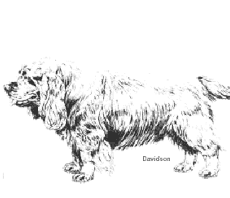Sussex Spaniel
General Information - Sussex Spaniel

Group:
Gundog
Size:
medium
Lifespan:
12-14 years
Exercise:
medium
Grooming:
medium
Trainability:
low
Watchdog ability:
high
Protection ability:
medium
Area of Origin:
England
Date of Origin:
1800’s
Other Names:
none
Original Function:
Small game tracking
and flushing
History
The Sussex was bred by Mr A Fuller from Sussex in the 1800s. He was bred for working in dense cover and so is low to the ground and powerfully built.
Temperament
The Sussex Spaniel is an energetic dog with a friendly temperament.
Upkeep
The Sussex needs daily exercise, but its needs can be met with a good walk on lead or a short romp in the yard. Given the chance, it will appreciate a longer foray into the field. It can live outdoors in temperate climates, as long as it has a warm shelter, but it generally does better as a house dog that also has access to a yard. The coat needs brushing and combing two to three times a week, plus scissoring every few months.
Sussex Spaniel
A breed standard is the guideline which describes the ideal characteristics, temperament, and appearance of a breed and ensures that the breed is fit for function with soundness essential. Breeders and judges should at all times be careful to avoid obvious conditions and exaggerations, as well as being mindful of features which could be detrimental in any way to the health, welfare or soundness of this breed.
Breed Standard - Sussex Spaniel
 General Appearance:
General Appearance: Massive and strongly built. An active, energetic, strong dog, whose characteristic movement is a decided roll and unlike that of any other Spaniel.
Head and Skull: The skull should be wide and show a moderate curve from ear to ear, neither flat nor apple headed, with a centre indentation and a pronounced stop. Brows frowning - occiput decided, but not pointed. Nostrils well developed and liver colour. A well balanced head.
Eyes: Hazel colour, fairly large, not too full, but soft expression and not showing the haw over much.
Ears: Thick, fairly large and lobe shape, set moderately low but above eye level. Should lie closely, hair soft and wavy, but not too profuse.
Mouth: Strong and level, neither over nor undershot, with a scissor bite.
Neck: Long, strong and slightly arched, not carrying the head much above the level of the back. Not much throatiness, but well marked frill.
Forequarters: The shoulders should be sloping and free; arms well boned as well as muscular. Knees large and strong, pasterns short and well boned. Legs rather short and strong, moderately well feathered.
Body: Chest deep and well developed; not too round and wide. Back and loin well developed and muscular both in width and depth. The back ribs must be deep. Whole body should be strong and level with no sign of waistiness from withers to hips.
Hindquarters: The thighs must be strongly boned as well as muscular; hocks large and strong, legs rather short and strong with good bone, moderately well feathered. The hind legs should not appear shorter than the forelegs, or be too much bent at the hocks so as to give a Setter appearance, which is objectionable. The hind legs should be well feathered above the hocks, but not much hair below the hocks.
Feet: Circular, well padded, well feathered between toes.
Tail: Set low and not carried above level of the back. Free actioned, thickly clothed with hair, but no feather. Customarily docked from 12.70-17.78 cm (5-7 in).
Coat: Abundant and flat with no tendency to curl and ample undercoat for weather resistance.
Colour: Rich, golden liver and hair shading to gold at the tips; the gold predominating. Dark liver or puce is objectionable.
Weight and Size: Ideal Weight - Dogs: 20.4 kg (45 lb) Bitches 18.2 kg (40 lb).
Height: 38 - 41 cm (15 - 16 in).
Note: Male animals should have two apparently normal testicles fully descended into the scrotum.
DNZ No 362
Copyright Dogs New Zealand
Print 06 Jan 2013
Any departure from the foregoing points should be considered a fault and the seriousness with which the fault should be regarded should be in exact proportion to its degree and its effect upon the health and welfare of the dog and on the dog’s ability to perform its traditional work.




